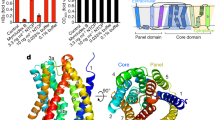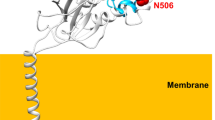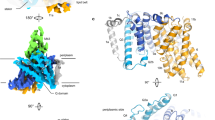Abstract
Amino-acid transport across cellular plasma membranes depends on several parallel-functioning (co-)transporters and exchangers1. The widespread transport system L accounts for a sodium-independent exchange of large, neutral amino acids, whereas the system y+L exchanges positively charged amino acids and/or neutral amino acids together with sodium2,3. The molecular nature of these transporters remains unknown, although expression of the human cell-surface glycoprotein 4F2 heavy chain (h4F2hc; CD98 in the mouse)4,5 is known to induce low levels of L- and/or y+L-type transport6,7,8,9. This glycoprotein is found in activated lymphocytes, together with an uncharacterized, disulphide-linked lipophilic light chain with an apparent relative molecular mass of 40,000 (Mr 40K)10,11. Here we identify the permease-related protein E16 (ref. 12) as the first light chain of h4F2hc and show that the resulting heterodimeric complex mediates L-type amino-acid transport. The homologous protein from Schistosoma mansoni, SPRM1, also associates covalently with coexpressed h4F2hc glycoprotein, although it induces amino-acid transport of different substrate specificity. The coexpression of h4F2hc is required for surface expression of these permease-related light chains, which belong to a new family of amino-acid transporters that form heterodimers with cell-surface glycoproteins.
This is a preview of subscription content, access via your institution
Access options
Subscribe to this journal
Receive 51 print issues and online access
$199.00 per year
only $3.90 per issue
Buy this article
- Purchase on SpringerLink
- Instant access to full article PDF
Prices may be subject to local taxes which are calculated during checkout






Similar content being viewed by others
References
Christensen, H. N. Role of amino acid transport and countertransport in nutrition and metabolism. Physiol. Rev. 70, 43–77 (1990).
Oxender, D. L. & Christensen, H. N. Distinct mediating systems for the transport of neutral amino acids by the Ehrlich cell. J. Biol. Chem. 238, 3686–3699 (1963).
Devés, R., Chavez, P. & Boyd, C. A. R. Identification of a new transport system (y+L) in human erythrocytes that recognizes lysine and leucine with high affinity. J. Physiol (Lond.) 454, 491–501 (1992).
Haynes, B. F.et al. Characterization of a monoclonal antibody (4F2) that binds to human monocytes and to a subset of activated lymphocytes. J. Immunol. 126, 1409–1414 (1981).
MacDonald, H. R., Lees, R. K. & Bron, C. Cell surface glycoproteins involved in the stimulation of interleukin 1-dependent interleukin 2 production by a subline of E14 thymoma cells. I. Functional characterization by monoclonal antibodies. J. Immunol. 135, 3944–3950 (1985).
Wells, R. G., Lee, W. S., Kanai, Y., Leiden, J. M. & Hediger, M. A. The 4F2 antigen heavy chain induces uptake of neutral and dibasic amino acids in Xenopus oocytes. J. Biol. Chem. 267, 15285–15288 (1992).
Bertran, J.et al. Stimulation of system y+-like amino acid transport by the heavy chain of human 4F2 surface antigen in Xenopus-laevis oocytes. Proc. Natl Acad. Sci. USA 89, 5606–5610 (1992).
Broër, S., Broër, A. & Hamprecht, B. The 4F2hc surface antigen is necessary for expression of system L-like neutral amino acid-transport activity in C6-BU-1 rat glioma cells: evidence from expression studies in Xenopus laevis oocytes. Biochem. J. 312, 863–870 (1995).
Broër, S., Broër, A. & Hamprecht, B. Expression of the surface antigen 4F2hc affects system-L-like neutral-amino-acid-transport activity in mammalian cells. Biochem. J. 324, 535–541 (1997).
Hemler, M. E. & Strominger, J. L. Characterization of antigen recognized by the monoclonal antibody (4F2): different molecular forms on human T and B lymphoblastoid cell lines. J. Immunol. 129, 623–628 (1982).
Lüscher, B., Rousseaux, M., Lees, R., MacDonald, H. R. & Bron, C. Cell surface glycoproteins involved in the stimulation of interleukin 1-dependent interleukin 2 production by a subline of E14 thymoma cells. II. Structure, biosynthesis, and maturation. J. Immunol. 135, 3951–3957 (1985).
Gaugitsch, H. W., Prieschl, E. E., Kalthoff, F., Huber, N. E. & Baumruker, T. Anovel transiently expressed, integral membrane protein linked to cell activation. J. Biol. Chem. 267, 11267–11273 (1992).
Spindler, B., Mastroberardino, L., Custer, M. & Verrey, F. Characterization of early aldosterone-induced RNAs identified in A6 kidney epithelia. Pflugers Arch. 434, 323–331 (1997).
Isnard, A. D., Thomas, D. & Surdin-Kerjan, Y. The study of methionine uptake in Saccharomyces cerevisiae reveals a new family of amino acid permeases. J. Mol. Biol. 262, 473–484 (1996).
Hofmann, K. & Stoffel, W. Profilegraph: an interactive graphical tool for protein sequence analysis. Comp. Appl. Biosci. 8, 331–337 (1992).
Palacin, M. Anew family of proteins (rBAT and 4F2hc) involved in cationic and zwitterionic amino acid transport: a tale of two proteins in search of a transport function. J. Exp. Biol. 196, 123–137 (1994).
Teixeira, S., Di Grandi, S. & Kuhn, L. C. Primary structure of the human 4F2 antigen heavy chain predicts a transmembrane protein with a cytoplasmic NH2 terminus. J. Biol. Chem. 262, 9574–9580 (1987).
Eisenbarth, G. S., Haynes, B. F., Schroer, J. A. & Fauci, A. S. Production of monoclonal antibodies reacting with peripheral blood mononuclear cell surface differentiation antigens. J. Immunol. 124, 1237–1244 (1980).
Geering, K., Theulaz, I., Verrey, F., Häuptle, M. T. & Rossier, B. C. Arole for the β-subunit in the expression of functional Na+-K+-ATPase in Xenopus oocytes. Am. J. Physiol. 257, C851–C858 (1989).
Wells, R. G. & Hediger, M. A. Cloning of a rat kidney cDNA that stimulates dibasic and neutral amino acid transport and has sequence similarity to glucosidases. Proc. Natl Acad. Sci. USA 89, 5596–5600 (1992).
Acknowledgements
We thank L. Kühn and M. Palacin for providing antibody and the h4F2hc cDNA, H.Murer and J. Biber for the Xenopus oocytes, and all four for helpful discussions. We also thank C. Gasser for artwork and L. Dionne, H. J. Kim and L. Kläusli for technical assistance. F.V.'s laboratory is supported by the Swiss NSF and the work in C.B.S.'s laboratory is supported by an NIH grant.
Author information
Authors and Affiliations
Corresponding author
Supplementary Information
Rights and permissions
About this article
Cite this article
Mastroberardino, L., Spindler, B., Pfeiffer, R. et al. Amino-acid transport by heterodimers of 4F2hc/CD98 and members of a permease family. Nature 395, 288–291 (1998). https://doi.org/10.1038/26246
Received:
Accepted:
Issue Date:
DOI: https://doi.org/10.1038/26246
This article is cited by
-
Structural basis for the inhibition mechanism of LAT1-4F2hc complex by JPH203
Cell Discovery (2024)
-
Cryo-EM structure of the human Asc-1 transporter complex
Nature Communications (2024)
-
m6A modification mediates SLC3A2/SLC7A5 translation in 3-methylcholanthrene-induced uroepithelial transformation
Cell Biology and Toxicology (2024)
-
Glial Glutamine Homeostasis in Health and Disease
Neurochemical Research (2023)
-
Induction of CTH expression in response to amino acid starvation confers resistance to anti-LAT1 therapy in MDA-MB-231 cells
Scientific Reports (2022)



